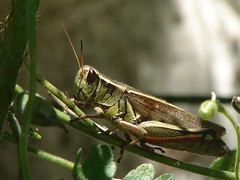The Secret Lives of Crickets
There is new research showing that crickets, the insects who hop around and annoy you with their constant chirpy attitude, share an unusual feature with whales and dolphins. Strange as it may seem, crickets and dolphins share one unique ability that separates them from most creatures in the animal kingdom. This feature has to do with their hearing and their ears, which are in a place you would be unlikely to guess.
The Connection between Crickets and Dolphins
Recent news has come to light showing that crickets, along with some other small insects, have eardrums located on their front legs. Noise seems to pass through lipids, or oils and fats located in the insect, to the organs. This new research may show how a cricket knows to jump out of your way when you are walking down a creaky hallway.
Dolphins also promote their own hearing in a similar way underwater. Although they don’t have legs, it is believed that dolphins can access sounds through their lower jaws. Sound frequencies travel through their bodies and promote hearing underwater, so that they can find food and protect themselves from predators. Their quick speed is also very reflective of the speed of most crickets, who often jump from place to place at a very fast rate.
Crickets are omnivorous insects that feed on plant material, both alive and decaying. Some gardeners may find them particularly problematic; however, most insecticides are effective on crickets. Carnivorous animals and insects are also known to eat crickets, so crickets are constantly either seeking food are running away from being food.
People in some parts of the world actually consider crickets a nutritious and delicious food item. In fact, you can find chocolate-covered crickets, fried crickets, and sautéed crickets. However strange this may seem to some, many countries consider this insect a popular delicacy.
Cricket Invasion?
Crickets mate in summer and lay eggs in autumn. It is best to start early in removing crickets from your area, no matter how small or large the population. Begin in late spring to early summer, as this will prevent the mating from occurring.
As mentioned, introducing insecticides in the area can be an option, as well as introducing carnivorous plants, animals, and insects that feed on crickets.



